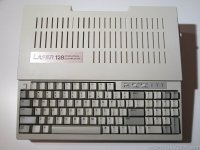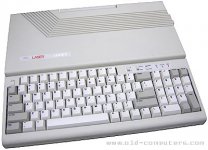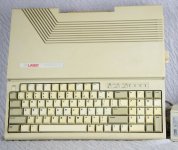SomeGuy
Veteran Member
I have been trying to sort out out the differences between the Laser 128, Laser 128EX, Laser and 128EX/2. While that information is all out there, it is scattered around. So, here is a compilation of what I have found:
Laser 128 Early version
---
The original Laser 128 has a case style with vertical vent slits on the top, and looks like this:

This is an Apple II clone with 128K RAM, an expansion port, built in serial/parallel, 80 columns, Microsoft BASIC, NTSC/PAL support, and internal disk drive.
The motherboard in this version is documented in the first revision of the Laser 128 Technical Reference (1986).
There is a good set of pictures here that shows this version inside and out:
https://www.nightfallcrew.com/wp-content/gallery/vtech-laser-128-personal-computer-apple-ii-clone/
Laser 128 revised
---
At the time the Laser 128EX was released, the case of style of the Laser 128 was also revised, identifiable by horizontal vent slits, and looks like this:

The revised Laser 128 also has a redesigned motherboard.
This version supports 3.5" drives, although reportedly older units can add support with a ROM upgrade.
Laser 128EX
---
The Laser 128EX uses an identical case to the revised 128. The Laser 128EX uses a different motherboard than the 128. The motherboard for both the revised 128 and 128EX are documented in the later revision of the technical reference manual.

Differences from the 128 include:
- Faster Speed CPU with speed switching
- Includes a memory expansion board that supports up to 1 megabyte of RAM, accessible as a RAM disk. This board was available as separate option for the regular Laser 128. Reportedly some Laser 128 (model id "Laser 128E") machines could be purchased with this option.
- Additional, faster video RAM to accommodate the faster CPU.
- A different CPU-memory interface
Laser 128EX/2
---
The 128EX/2 managed to stuff even more in to this already jam packed Apple II clone:
- Slightly different case, but similar style.
- Built in real time clock
- Built in MIDI port
- Internal 3.5" floppy drive, although optionally an EX/2 could use a 5.25" drive instead.
- Revision 6.1 ROM control panel for setting clock, controlling boot, and setting speed.
- The 128EX/2's Video Display Generator chip provides both analog RGB video (for connecting an Apple IIGS, Amiga, or Atari ST monitor) and digital RGB video (for connecting a CGA monitor). In RGB mode, the Video Display Generator (VDG) chip generates a text character set identical to an IBM PC (with the addition of the Open and Closed Triangle characters)
Oddly, I can't seem to find any photos on line of an EX/2.
Reportedly, the exact same case as the 128EX/2 was also used for the Laser XT IBM PC compatible.

Misc:
The keyboard in the original 128 looks a bit different.
Did the very earliest 128s really work with 3.5" drives after a ROM upgrade? And did that include both Laser (Macintosh interface) and Apple Unidisk drives?
I discussed compatibility with the Laser 3.5" floppy drive here: http://www.vcfed.org/forum/showthre...loppy-drive-compatiblity-information&p=533803
Some sources (including the later user manual) seem to suggest only the EX and EX/2 support 3.5" drives, but that is absolutely not true.
If I understand it right, the original Laser 128 needs a slightly different memory expansion card.
ROM
----
There seems to be no documentation about the different ROM versions. From what I can determine:
At some point 3.5" drive support was added. A ROM upgraded would add support to existing machines.
Numerous minor revisions appear in different machines (2.9, 4.2, 4.5, 5.0, 6.0)
The 128 and 128EX use identical ROMs.
The last ROM for the 128 and 128EX seems to be version 6.0.
The 128EX/2 has ROM 6.1, but the additions are not useful in a 128 or 128EX.
Laser 128 Early version
---
The original Laser 128 has a case style with vertical vent slits on the top, and looks like this:

This is an Apple II clone with 128K RAM, an expansion port, built in serial/parallel, 80 columns, Microsoft BASIC, NTSC/PAL support, and internal disk drive.
The motherboard in this version is documented in the first revision of the Laser 128 Technical Reference (1986).
There is a good set of pictures here that shows this version inside and out:
https://www.nightfallcrew.com/wp-content/gallery/vtech-laser-128-personal-computer-apple-ii-clone/
Laser 128 revised
---
At the time the Laser 128EX was released, the case of style of the Laser 128 was also revised, identifiable by horizontal vent slits, and looks like this:

The revised Laser 128 also has a redesigned motherboard.
This version supports 3.5" drives, although reportedly older units can add support with a ROM upgrade.
Laser 128EX
---
The Laser 128EX uses an identical case to the revised 128. The Laser 128EX uses a different motherboard than the 128. The motherboard for both the revised 128 and 128EX are documented in the later revision of the technical reference manual.

Differences from the 128 include:
- Faster Speed CPU with speed switching
- Includes a memory expansion board that supports up to 1 megabyte of RAM, accessible as a RAM disk. This board was available as separate option for the regular Laser 128. Reportedly some Laser 128 (model id "Laser 128E") machines could be purchased with this option.
- Additional, faster video RAM to accommodate the faster CPU.
- A different CPU-memory interface
Laser 128EX/2
---
The 128EX/2 managed to stuff even more in to this already jam packed Apple II clone:
- Slightly different case, but similar style.
- Built in real time clock
- Built in MIDI port
- Internal 3.5" floppy drive, although optionally an EX/2 could use a 5.25" drive instead.
- Revision 6.1 ROM control panel for setting clock, controlling boot, and setting speed.
- The 128EX/2's Video Display Generator chip provides both analog RGB video (for connecting an Apple IIGS, Amiga, or Atari ST monitor) and digital RGB video (for connecting a CGA monitor). In RGB mode, the Video Display Generator (VDG) chip generates a text character set identical to an IBM PC (with the addition of the Open and Closed Triangle characters)
Oddly, I can't seem to find any photos on line of an EX/2.
Reportedly, the exact same case as the 128EX/2 was also used for the Laser XT IBM PC compatible.

Misc:
The keyboard in the original 128 looks a bit different.
Did the very earliest 128s really work with 3.5" drives after a ROM upgrade? And did that include both Laser (Macintosh interface) and Apple Unidisk drives?
I discussed compatibility with the Laser 3.5" floppy drive here: http://www.vcfed.org/forum/showthre...loppy-drive-compatiblity-information&p=533803
Some sources (including the later user manual) seem to suggest only the EX and EX/2 support 3.5" drives, but that is absolutely not true.
If I understand it right, the original Laser 128 needs a slightly different memory expansion card.
ROM
----
There seems to be no documentation about the different ROM versions. From what I can determine:
At some point 3.5" drive support was added. A ROM upgraded would add support to existing machines.
Numerous minor revisions appear in different machines (2.9, 4.2, 4.5, 5.0, 6.0)
The 128 and 128EX use identical ROMs.
The last ROM for the 128 and 128EX seems to be version 6.0.
The 128EX/2 has ROM 6.1, but the additions are not useful in a 128 or 128EX.



